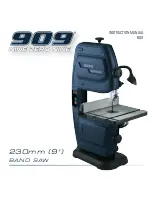
7
1/8" - 1/4" (3 mm - 6 mm)
• Support large panels to minimise the risk of
blade pinching and kickback.
Large panels tend
to sag under their own weight. Supports must be
placed under the panel on both sides, near the line
of cut and near the edge of the panel.
• Do not use dull or damaged blades.
Unsharpened
or improperly set blades produce narrow kerf caus-
ing excessive friction, blade binding and kickback.
• Avoid overheating the blade tips and, if cutting
plastics is permitted, to avoid melting the plastic.
• Blade depth and bevel adjusting locking levers
must be tight and secure before making cut.
If
blade adjustment shifts while cutting, it may cause
binding and kickback.
• Use extra caution when sawing into existing
walls or other blind areas.
The protruding blade
may cut objects that can cause kickback.
Tighten depth and
miter adjusting levers
securely
Set depth of cut
1/8"-1/4" greater than
thickness of stock
Rest saw on larger
part of workpiece,
allowing smaller part
to fall away
Secure work-
piece to sturdy
supports
Firm
footing
in clean
area
Wear safety
goggles
Grip saw with
both hands,
keeping hands
away from
blade
General Operation
Always clamp workpiece securely on a saw horse
or bench. See “Applications” for the correct way to
support your work in different situations. A typical
application is shown below.
1. Draw cutting line. Place front of shoe on edge of
workpiece without making blade contact. Hold
switch handle with one hand and top handle with
the other.
2. Line up sighting notch with your cutting line. Posi
-
tion arms and body to resist kickback. Pull trigger,
allowing motor to reach full speed before beginning
cut.
3. While cutting, keep shoe flat against workpiece and
maintain a firm grip. Do not force saw through the
work. Forcing a saw can cause kickback.
4. If making a partial cut, restarting in mid-cut or
correcting direction, allow blade to come to a
complete stop. To resume cutting, center blade
in kerf, back saw away from cutting edge a few
inches, pull trigger and re-enter cut slowly.
5. If saw stalls, maintain a firm grip and release trig
-
ger immediately. Correct problem before continu
-
ing (see “Preventing Kickback”).
6. After finishing a cut, be sure lower guard closes
and blade comes to a complete stop before setting
down saw.























